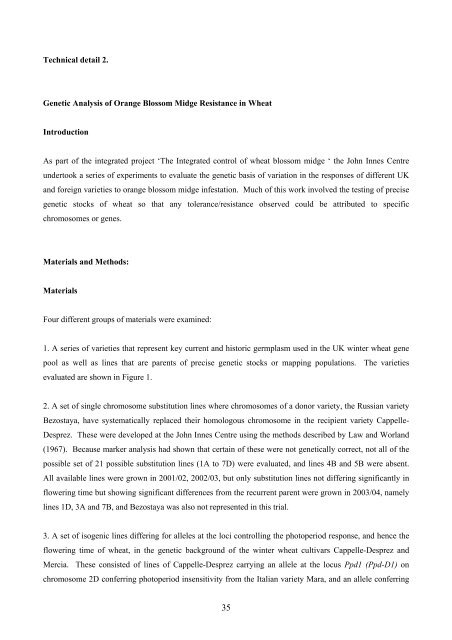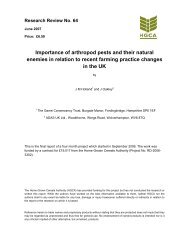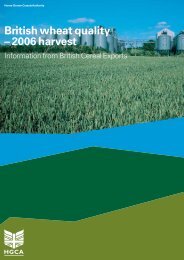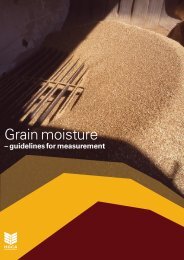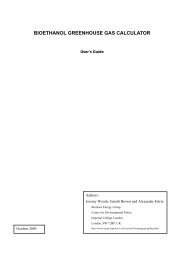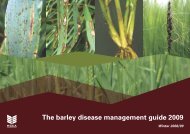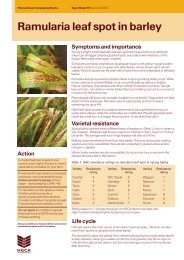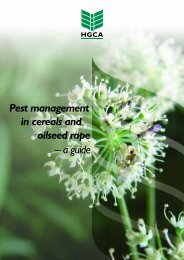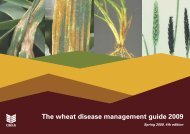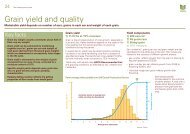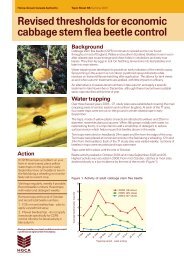Integrated control of wheat blossom midge - HGCA
Integrated control of wheat blossom midge - HGCA
Integrated control of wheat blossom midge - HGCA
Create successful ePaper yourself
Turn your PDF publications into a flip-book with our unique Google optimized e-Paper software.
Technical detail 2.Genetic Analysis <strong>of</strong> Orange Blossom Midge Resistance in WheatIntroductionAs part <strong>of</strong> the integrated project ‘The <strong>Integrated</strong> <strong>control</strong> <strong>of</strong> <strong>wheat</strong> <strong>blossom</strong> <strong>midge</strong> ‘ the John Innes Centreundertook a series <strong>of</strong> experiments to evaluate the genetic basis <strong>of</strong> variation in the responses <strong>of</strong> different UKand foreign varieties to orange <strong>blossom</strong> <strong>midge</strong> infestation. Much <strong>of</strong> this work involved the testing <strong>of</strong> precisegenetic stocks <strong>of</strong> <strong>wheat</strong> so that any tolerance/resistance observed could be attributed to specificchromosomes or genes.Materials and Methods:MaterialsFour different groups <strong>of</strong> materials were examined:1. A series <strong>of</strong> varieties that represent key current and historic germplasm used in the UK winter <strong>wheat</strong> genepool as well as lines that are parents <strong>of</strong> precise genetic stocks or mapping populations. The varietiesevaluated are shown in Figure 1.2. A set <strong>of</strong> single chromosome substitution lines where chromosomes <strong>of</strong> a donor variety, the Russian varietyBezostaya, have systematically replaced their homologous chromosome in the recipient variety Cappelle-Desprez. These were developed at the John Innes Centre using the methods described by Law and Worland(1967). Because marker analysis had shown that certain <strong>of</strong> these were not genetically correct, not all <strong>of</strong> thepossible set <strong>of</strong> 21 possible substitution lines (1A to 7D) were evaluated, and lines 4B and 5B were absent.All available lines were grown in 2001/02, 2002/03, but only substitution lines not differing significantly inflowering time but showing significant differences from the recurrent parent were grown in 2003/04, namelylines 1D, 3A and 7B, and Bezostaya was also not represented in this trial.3. A set <strong>of</strong> isogenic lines differing for alleles at the loci <strong>control</strong>ling the photoperiod response, and hence theflowering time <strong>of</strong> <strong>wheat</strong>, in the genetic background <strong>of</strong> the winter <strong>wheat</strong> cultivars Cappelle-Desprez andMercia. These consisted <strong>of</strong> lines <strong>of</strong> Cappelle-Desprez carrying an allele at the locus Ppd1 (Ppd-D1) onchromosome 2D conferring photoperiod insensitivity from the Italian variety Mara, and an allele conferring35


